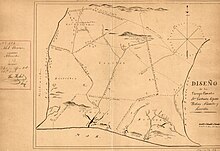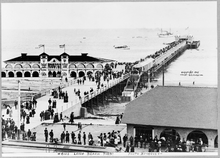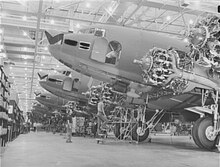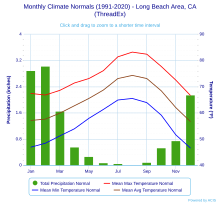
A | B | C | D | E | F | G | H | CH | I | J | K | L | M | N | O | P | Q | R | S | T | U | V | W | X | Y | Z | 0 | 1 | 2 | 3 | 4 | 5 | 6 | 7 | 8 | 9
Long Beach, California | |
|---|---|
|
| |
| Nickname: "Aquatic Capital of America"[1] | |
| Motto: "The International City" | |
| Coordinates: 33°46′6″N 118°11′44″W / 33.76833°N 118.19556°W | |
| Country | United States |
| State | California |
| County | Los Angeles |
| CSA | Los Angeles-Long Beach |
| MSA | Los Angeles-Long Beach-Anaheim |
| Incorporated | December 13, 1897[2] |
| Government | |
| • Type | Council-manager[3] |
| • Mayor | Rex Richardson[4] |
| • Vice Mayor | Cindy Allen |
| • Legislative body | City Council[5] |
| • City manager | Tom Modica[6] |
| Area | |
| • City | 80.35 sq mi (208.10 km2) |
| • Land | 50.70 sq mi (131.32 km2) |
| • Water | 29.64 sq mi (76.77 km2) 2.22% |
| Elevation | 52 ft (16 m) |
| Population | |
| • City | 466,742 |
| • Rank | 43rd in the United States 7th in California |
| • Density | 9,205.96/sq mi (3,554.23/km2) |
| Time zone | UTC-08:00 (Pacific) |
| • Summer (DST) | UTC-07:00 (PDT) |
| ZIP Codes[10] | 90801–90810, 90813–90815, 90822, 90831–90835, 90840, 90842, 90844, 90846–90848, 90853, 90895, 90899 |
| Area code | 562 |
| FIPS code | 06-43000 |
| GNIS feature IDs | 1652747, 2410866 |
| Website | www |
Long Beach is a city in Los Angeles County, California, United States. It is the 43rd-most populous city in the United States, with a population of 451,307 as of 2022.[11] A charter city,[3] Long Beach is the seventh-most populous city in California, the second most populous city in Los Angeles County, and the largest city in California that is not a county seat city.
Incorporated in 1897, Long Beach lies in Southern California, in the southern part of Los Angeles County.[12] Long Beach is approximately 20 miles (32 km) south of downtown Los Angeles, and is part of the Gateway Cities region. The Port of Long Beach is the second busiest container port in the United States and is among the world's largest shipping ports.[13] The city is over an oilfield with minor wells both directly beneath the city as well as offshore.
The city is known for its waterfront attractions, including the permanently docked RMS Queen Mary and the Aquarium of the Pacific. Long Beach also hosts the Grand Prix of Long Beach, an IndyCar race and the Long Beach Pride Festival and Parade. California State University, Long Beach, one of the largest universities in California by enrollment, is within the city.
History
Tongva period

Indigenous people have lived in coastal Southern California for over 10,000 years, and several successive cultures have inhabited the present-day area of Long Beach. By the 16th-century arrival of Spanish explorers, the dominant group was the Tongva, who had established at least three major settlements within the present-day city. Tevaaxa'anga was an inland settlement near the Los Angeles River, while Ahwaanga and Povuu'nga were coastal villages.[14] Povuu'nga was particularly important to the Tongva, not only as a regional trading center and hub for fishermen,[15] but for its deep ceremonial significance, being understood as their place of emergence as a people from which their lives began.[16]
Spanish and Mexican period


In 1784, the Spanish Empire's King Carlos III granted Rancho Los Nietos to Spanish soldier Manuel Nieto. The Rancho Los Cerritos and Rancho Los Alamitos were divided from this territory. The boundary between the two ranchos ran through the center of Signal Hill on a southwest to northeast diagonal. A portion of western Long Beach was originally part of the Rancho San Pedro. Its boundaries were in dispute for years, due to flooding changing the Los Angeles River boundary between Rancho San Pedro and Rancho Los Nietos.
By 1805, what had been the major Tongva village of Puvunga was thoroughly depleted of villagers, most of whom were brought to Mission San Gabriel for conversion and as a labor force.[15][17] Many villagers died at the mission, which had a high rate of death, particularly among children,[18] attributed to many factors like diseases that spread quickly in the close quarters of the mission's walls, as well as torture, malnourishment, and overworking.[19]

In 1843, Juan Temple bought Rancho Los Cerritos, having arrived in California in 1827 from New England. He built what is now known as the "Los Cerritos Ranch House", a still-standing adobe which is a National Historic Landmark. Temple created a thriving cattle ranch and prospered, becoming the wealthiest man in Los Angeles County. Both Temple and his ranch house played important local roles in the Mexican–American War. On an island in the San Pedro Bay, Mormon pioneers made an abortive attempt to establish a colony (as part of Brigham Young's plan to establish a continuous chain of settlements from the Pacific to Salt Lake).
Post-Conquest period

Following the U.S. Conquest of California, Temple had his Rancho Los Cerritos deeded to him by the Public Land Commission. In 1866, Temple sold Rancho Los Cerritos for $20,000 to the Northern California sheep-raising firm of Flint, Bixby & Company, which consisted of brothers Thomas and Benjamin Flint and their cousin Llewellyn Bixby. Two years previous Flint, Bixby & Co had also purchased along with Northern California associate James Irvine, three ranchos which would later become the city that bears Irvine's name. To manage Rancho Los Cerritos, the company selected Llewellyn's brother Jotham Bixby, the "Father of Long Beach". Three years later, Bixby bought into the property and would later form the Bixby Land Company. In the 1870s, as many as 30,000 sheep were kept at the ranch and sheared twice yearly to provide wool for trade. In 1880, Bixby sold 4,000 acres (16 km2) of the Rancho Los Cerritos to William E. Willmore, who subdivided it in hopes of creating a farm community, Willmore City. He failed and was bought out by a Los Angeles syndicate that called itself the "Long Beach Land and Water Company". They changed the name of the community to Long Beach at that time.
Incorporation


The City of Long Beach was officially incorporated in 1897. The town grew as a seaside resort with light agricultural uses.[20] The Pike was the most famous beachside amusement zone on the West Coast from 1902 until 1969; it offered bathers food, games and rides, such at the Sky Wheel dual Ferris wheel and Cyclone Racer roller coaster. Gradually the oil industry, Navy shipyard and facilities and port became the mainstays of the city. In the 1950s it was referred to as "Iowa by the sea", due to a large influx of people from that and other Midwestern states. Huge picnics for migrants from each state were a popular annual event in Long Beach until the 1960s. Another Bixby cousin, John W. Bixby, was influential in the city. After first working for his cousins at Los Cerritos, J.W. Bixby leased land at Rancho Los Alamitos. He put together a group: banker I.W. Hellman, Llewellyn and Jotham Bixby, and him, to purchase the rancho. In addition to bringing innovative farming methods to the Alamitos (which under Abel Stearns in the late 1850s and early 1860s was once the largest cattle ranch in the US), J.W. Bixby began the development of the oceanfront property near the city's picturesque bluffs. Under the name Alamitos Land Company, J.W. Bixby named the streets and laid out the parks of his new city. This area would include Belmont Heights, Belmont Shore and Naples; it soon became a thriving community of its own. J.W. Bixby died in 1888 of apparent appendicitis. The Rancho Los Alamitos property was split up, with Hellman getting the southern third, Jotham and Llewellyn, the northern third, and J.W. Bixby's widow and heirs keeping the central third. The Alamitos townsite was kept as a separate entity, but at first, it was primarily run by Llewellyn and Jotham Bixby, although I.W, Hellman (who had the largest single share) had a significant veto power, an influence made even stronger as the J.W. Bixby heirs began to side with Hellman more and more.
When Jotham Bixby died in 1916, the remaining 3,500 acres (14 km2) of Rancho Los Cerritos was subdivided into the neighborhoods of Bixby Knolls, California Heights, Los Cerritos, North Long Beach and part of the city of Signal Hill.
Pine Avenue near 4th became the center of a large shopping district. Besides upscale Buffums (1912; expanded 1926),[21] in 1929 alone Barker Brothers, the Hugh A. Marti Co., and Wise Company and Famous department stores built large new stores,[22][23] Walker's (1933), and nearby at American and 5th, Sears (1928) and Montgomery Ward (1929). It would remain popular until suburban malls sprung up starting in the 1950s. (see also: History of Retail in Southern California)
Oil was discovered in 1921 on Signal Hill, which split off as a separately incorporated city shortly afterward. The discovery of the Long Beach Oil Field, brought in by the gusher at the Alamitos oil well #1, made Long Beach a major oil producer; in the 1920s the field was the most productive in the world.[24] In 1932, the even larger Wilmington Oil Field, fourth-largest in the United States, and which is mostly in Long Beach, was developed, contributing to the city's fame in the 1930s as an oil town.[25][26]
The M6.4 1933 Long Beach earthquake caused significant damage to the city and surrounding areas, killing a total of 120 people. Most of the damage occurred in unreinforced masonry buildings, especially schools. Pacific Bible Seminary (now known as Hope International University) was forced to move classes out of First Christian Church of Long Beach and into a small local home due to damage.[27]



The Ford Motor Company built a factory called Long Beach Assembly at the then address in 1929 as "700 Henry Ford Avenue, Long Beach" where the factory began building the Ford Model A. Production of Ford vehicles continued after the war until 1960, when the plant was closed due to a fire,[29] and January 1991 when the factory was demolished partially due to air quality remediation efforts. Ford had earlier opened a factory in Los Angeles at 12th Street and Olive, with a later factory built at East Seventh Street and Santa Fe Avenue after 1914.[30]
Come 1938, the creation of Housing Authorities for both the City and County of Los Angeles were complete — and North Long Beach was to be home to the County Authority's first order of business: the Carmelitos Housing Project, Southern California's first affordable housing complex.[26]
World War II
Long Beach, as a port city, had a relationship with the U.S. Navy even before the war.[31] The city was part of the Battle of Los Angeles during World War II when observers for the United States Army Air Forces reported shells being fired from the sea. Anti-aircraft batteries fired into the night sky, although no planes were ever sighted.
Long Beach's population grew substantially during and after the war, with workers being needed for wartime manufacturing and G.I. bill recipients seeking out homes in California.[31] Suburbs were built by the Bixby land companies and others.[31]
Douglas Aircraft Company's largest facility was its Long Beach plant, totaling 1,422,350 square feet (132,141 m2). The first plane rolled out the door on December 23, 1941. The plant produced C-47 Skytrain transports, B-17 Flying Fortress bombers, and A-20 Havoc attack bombers simultaneously. Douglas merged with the McDonnell Aircraft Company in 1967 where the Douglas DC-8 and the McDonnell Douglas DC-9 were built. In 1997 McDonnell Douglas merged with Boeing, which made C-17 Globemaster transport planes in Long Beach until the closure of the manufacturing facility in 2015.[32][33]
Geography
Long Beach is about 21 miles (34 km) south of downtown Los Angeles. According to the United States Census Bureau, the city has a total area of 80.35 square miles (208.1 km2), of which 50.70 square miles (131.3 km2) is land and 29.64 square miles (76.8 km2) (36.8%) is water. Long Beach completely surrounds the city of Signal Hill.
Climate
Long Beach has a climate that can either be described as a hot semi-arid climate or a hot-summer Mediterranean climate. In general, the city features hot summers and mild to warm winters with occasional rainfall. Days in Long Beach are mostly sunny, as in Southern California in general. Temperatures recorded at the weather station at the Long Beach Airport, 4.0 miles (6.4 km) inland from the ocean, range more greatly than those along the immediate coast. During the summer months, low clouds and fog occur frequently, developing overnight and blanketing the area on many mornings. This fog usually clears by the afternoon, and a westerly sea breeze often develops, keeping temperatures mild. Heat and high humidity can sometimes coincide in summer, which may cause discomfort due to the heat index.[34]
According to data analysis provided by the NWS, The annual average temperature of Long Beach is 64.9 °F (18.3 °C), of which August is the hottest month with an average temperature of 74.3 °F (23.5 °C), while December is the coldest month with an average temperature of 56.7 °F (13.7 °C).[35] In terms of temperature, Long Beach and other California cities such as Los Angeles and San Francisco have the hottest month of the year usually in August and the coolest month in December. Long Beach has 23 days of afternoon temperatures above 90 °F (32.2 °C) each year, and about two days a year are above 100 °F (37.8 °C).[36]

Long Beach's location directly east of the Palos Verdes Peninsula, paired with its south facing coastline, results in the city sometimes experiencing different weather patterns than the Los Angeles metropolitan area coastal communities to the northwest and southeast of Long Beach, which largely have west facing coastlines. The 1200 ft Palos Verdes hills block west to east airflow and a significant amount of the coastal moisture that marks other coastal cities, such as Manhattan Beach, Santa Monica, and Newport Beach.
As in most locations in Southern California, most rainfall in Long Beach occurs during the winter months. Storms can bring heavy rainfall.[37] The annual precipitation in Long Beach is 12.02 inches (305.3 mm), of which the precipitation from December to March of the following year accounts for 81% of the whole year.[35] June to September is usually rainless, especially August.[36]












